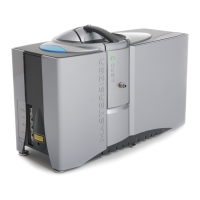Hardware features
19
Upper externally regulated dispersant inlet port - for
non-aqueous dispersants
For non-aqueous samples a direct input is available — the upper dispersant inlet port.
This will be connected to a separately enabled dispersant supply. This inlet port is chem-
ically compatible - refer to Hydro EV on page109.
In the software this upper dispersant inlet port is referred to as Automatic Fill (External).
The valve will be in a closed state when in standby or when power is supplied to the
accessory.
Refer to the Mastersizer 3000 Basic Guide for the site requirements of the dispersant
input.
Note: The upper dispersant inlet has no internal regulator to control the dis-
persant input. It is therefore recommended that the supply to this inlet is
enabled and controlled through the use of an external pump and cable.
Connection of the upper/non-aqueous dispersant pipe
1. The non-aqueous dispersant pipe is simply pushed onto the non-aqueous inlet
port.
2. Make sure it is pushed on as fully as possible to prevent any leaking risk.
Removal is the reverse of the procedure.
Note: Suitably compatible sample pipes must be used for any non-aqueous
solvent used. The inlet pipe has an outside diameter of 1/4 inch (6.35 mm). Suit-
able non-aqueous sample pipes are available direct from Malvern Instruments.
Note: Using the Accessory controls in the SOP, the inlet ports can be used for
both tank filling, and cleaning. Refer to Accessory control settings — Hydro
LV/MV in the Masteriszer 3000 user manual.

